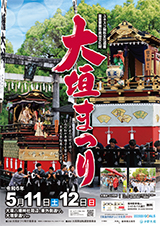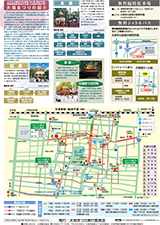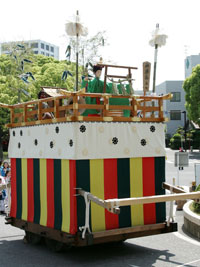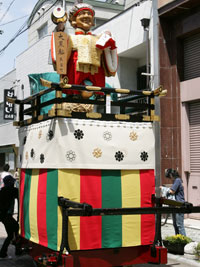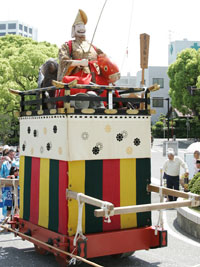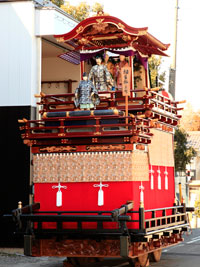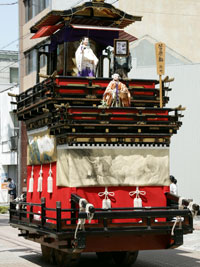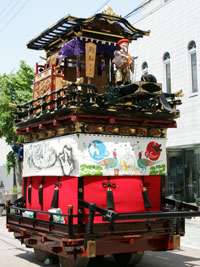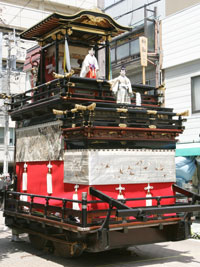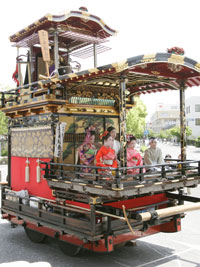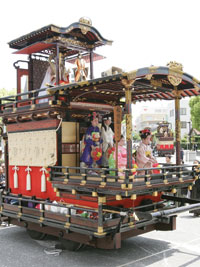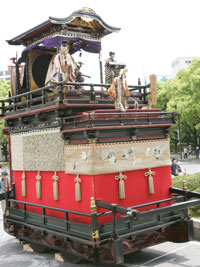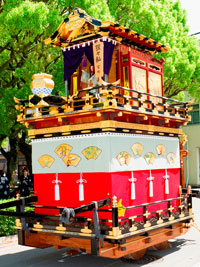
Registered as Intangible Cultural Heritage by UNESCO
on December 1st, 2016
The Japanese Agency of Cultural Affairs proposed to the United Nations Educational, Scientific and Cultural Organization (UNESCO) that the yama, hoko, and yatai float festivals of Japan, including the Ogaki festival float parade, be added to the Representative List of the Intangible Cultural Heritage of Humanity. On December 1st, 2016, at the UNESCO's Intergovernmental Committee held in Ethiopia, this proposal was accepted, and these events were registered as Intangible Cultural Heritage. This is the first Intangible Cultural Heritage in Ogaki to be registered.
![]() Features of Ogaki Festival
Features of Ogaki Festival
The Ogaki festival yama (or float) parade has been handed down as a castle-district festival event which has come to represent the Mino region. At this festival, the Ogaki feudal lord's yama and the yama of the townspeople were displayed together, a very rare case in Japan.
The Ogaki festival is a product of the interaction and exchange of festival culture between the eastern and western regions of Japan. The dashi (festival car) events of the Chukyo area have influenced the karakuri dolls in Ogaki, just as the dashi events in the Kinki region have influenced the performances on the yama. This interaction is considered to be very important in understanding the dissemination and changes in Japan's yama, hoko, and yatai events.
(short version)
(extended version)
- When:
- Saturday, May 11 and Sunday, May 12, 2024
- Where:
- Ogaki Hachiman Shrine area, Higashitogawa Street,
Ogaki Station Street, and the surrounding area. - Access:
- 5 min. walk from South Exit of JR Ogaki Station
*Please use the Paid parking if coming by public transportation or car. However, the Higashitogawa Parking Garage is not available as it is within the restricted traffic zone.
In addition, Free temporary parking lots are available. For details, please see the reverse side of the flyer. - Organizer:
- Ogaki Festival Executive Committee


Shigaku (First day - Saturday, May 11)
| Time | Activity | Location |
|---|---|---|
| 8:15~ | Shrine ritual and dedication performance |
In front of Ogaki Hachiman Shrine |
| 9:30~ | Inspection performance Yama parade (independent routes) |
In front of the Ogaki City Hall Around the old city district |
| 19:00~21:00 | Night parade | In front of Ogaki Hachiman Shrine~Tatsunokuchi Bridge |
| Time | Activity | Location |
|---|---|---|
| 8:30~10:30 | Dedication performance | In front of Ogaki Hachiman Shrine |
| 10:35~16:00 | Yama parade (western route) | Around the old city district |
| 16:00~ | Inspection performance | On Ogaki Station Street |
| 16:10~16:30 | Shrine ritual | Shinōhashi intersection |
| 16:30~17:20 | Ogaki festival procession | |
| 19:00~21:00 | Night parade | In front of Ogaki Hachiman Shrine~Tatsunokuchi Bridge |
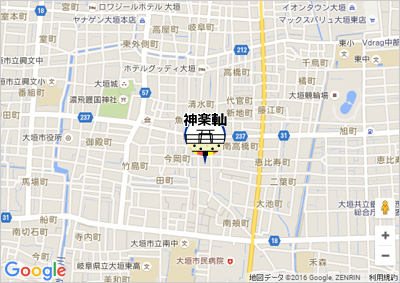
[yama location guide]
The real-time location of the yama on parade will be displayed here.
(This guide will only function during the Ogaki festival.)
Ogaki Festival, over 370 years of proud tradition
In 1679, Lord Ujiaki Toda had three additional yama built, which were named Kagura, Daikoku, and Ebisu. The ten Ogaki districts then added more elaborate decorations to their own yama.
Many of the yama were lost in the Great Nobi Earthquake and during World War II. However, some were repaired and restored, and others rebuilt. In 2012, replicas of the last two yama were completed, putting all thirteen yama together again for the first time in 70 years.
2015 Designated as an Important Intangible Folk Cultural Asset by Japan
2016 Registered as Intangible Cultural Heritage by UNESCO

A beautiful parade of thirteen yama
On Hongaku (the second day of the festival, Sunday), beginning at 8:45 am, each yama is again presented in front of Hachiman Shrine. After this, the thirteen yama are paraded together along the same route around the castle district. At 4:20 pm, the Ogaki festival procession is held, followed by another night parade beginning at 7:00 pm.
As would be expected for the largest festival in the region, large crowds line the roads, and the castle district is caught up in the beauty of the yama and in the excitement on the streets.

created by Ogaki Area Portal Site Nishi-Mino
created by Ogaki Cable TV
Hougei(Dedication Performace)
Shigaku: 8:15 a.m.~ Hongaku: 8:30 a.m.~ |
 |
|
 |
Kakegei(Inspection Performance)
Shigaku: 9:30 a.m.~ Hongaku: 4:00 p.m.~ |
 |
|
 |
This event originates from when the feudal lord of Ogaki used to have the yama pulled into Ogaki Castle for inspection. Today, the mayor of Ogaki serves this role in place of the feudal lord. During the Hongaku (second day), each yama does their inspection performance on Ogaki Station Road.
Night parade
Shigaku: 7:00 p.m.~ Hongaku: 7:00 p.m.~ |
 |
|
 |
※On the second day, the shrine presentations aren't performed.
Yama Parade
Shigaku: 11:30 a.m.~ Hongaku: 10:35 a.m.~ |
 |
|
 |
At 4:30 pm, the thirteen yama, accompanied by mikoshi (portable shrines), parade in the Ogaki festival procession, beginning at the Shin-ohashi Bridge and finishing in front of Hachiman Shrine.
Stands
 |
 |
|
 |
- ・Kagura
- ・Daikoku
- ・Ebisu
- ・Aioi
- ・Hotei
- ・Sugawara
- ・Namazu
- ・Sakaki
- ・Urashima
- ・Tamanoi
- ・Shōchiku
- ・Atago
- ・Shōjō
Kagura 【Honmachi/Nakamachi/Shinmachi】
The miko does a dance of prayer and purification while ringing a bell. The yamabushi holds bamboo grass in both hands while sprinkling flowers into a hot bath to purify it. The flowers (actually confetti) that it scatters symbolizes purification and the healing of disease.
The miko puppet is called Ichi, named after a beautiful miko that used to be at Hachiman Shrine
Daikoku 【Uoya-cho/Takejima-cho/Tawaramachi】
The people from Uoya-cho, Takejima-cho, and Tawaramachi take turns annually pulling this yama. It is a custom to not kill mice, which are strongly associated with Okuninushi-no-mikoto (another name for Daikokuten), in the district that is responsible for the yama that year.
Ebisu 【Funamachi/Tenma-cho/Gifumachi/Miyamachi】
It is said that the famous artist Hidari Jingoro made a sculpture of the great god Ebisu. When the god's face began peeling, a painter began to repaint it; however, when the he touched the face, flames began shooting from its mouth.
On the second evening of the festival, when all the events are finished and all the other yama have been pulled away, the people from the district responsible for this yama that year ceremonially hand it off to the next district at the O-kashira-watashi (literally 'passing the head') ceremony. This ceremony has continued unchanged for hundreds of years.
Funamachi/Tenma-cho/Gifumachi/Miyamachi take turns in alternate years pulling this yama.
Aioi 【Honmachi】
Dancing to the song Takasago (also known as Shikainami), Kannushi Tomonari from Aso moves quietly towards the center of the stage. The sight of Kannushi Tomonari suddenly turning into a sailboat at the climax of the music is quite impressive. After this the karakuri doll Sumiyoshi Myōjin begins his performance, playing with his sleeves and putting on his mask while dancing powerfully. The dancing of the doll and the townspeople's performance of the traditional festival song Kamimai is very powerful.
Hotei 【Nakamachi】
The karakuri doll holds a folding fan in its right hand while dancing and gradually moving towards the pedestal on top of the yama in the right corner. It then places its left hand on the pedestal, pulls itself up and balances on that hand, and then opens the fan in its right hand, while rotating around the pedestal. Hotei is the only yama to have karakuri dolls so far apart
This yama was destroyed by fire in the Great Nobi Earthquake of 1891, but rebuilt in 1902. It was lost to fire again in 1945 during an air raid, and then finally rebuilt again in 2012.
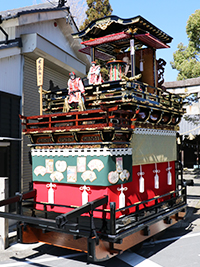
Sugawara 【Shinmachi】
There are three Japanese karakuri on this float, one shio-furi dancer, one calligraphy writer, and one frame holder. The karakuri doll that writes is special in that it is controlled by a combination of strings and indirect methods without using tane-ita. A person (or persons) about two meters below controls the doll, having it write kanji characters with individual strokes, which requires a great deal of intense practice.
The famous artist Suiseki Ohashi painted a tiger on the miokuri (rear banner) of the yama, and painted an ink-wash dragon on the maemizuhiki (front banner), which was very uncommon.
Namazu 【Uoya-cho】
A high priest during the Muromachi Period once famously asked "How can one catch a slippery, scale-less catfish living in muddy water with a round, shallow gourd?" The famous ink-wash painter Josetsu created his most famous painting Hyonenzu (Catching a Catfish with a Gourd), a national treasure, to illustrate this riddle, and this yama was based on that painting.
Sakaki 【Takejima-cho】
However, after the Shinbutsu-Bunri-Rei (orders separating Shinto and Buddhism, creating a violent anti-Buddhist movement) of the Meiji Restoration, this style of yama was abolished and it was replaced with Sakaki.
The top of this yama is decorated with sakaki (a type of tree) and sacred mirrors. The goddess Ame-no-Uzume holds a bell and sasaki branch and dances to quiet noh music. The ability to grasp the bell and wood from atop a plain wood pedestal is this karakuri's special attraction.
Urashima 【Tawaramachi】
The decorative columns are square and painted red. On the second day, the front banner depicts high waves, while the lower banners are made of felt and depict rogue waves embroidered with golden thread. On the first day, a white background is used.
This yama is known for its differences from the others, including having the yakata shaped in a rounded arc modeled after Ryugu Castle (from the Urashima story), and using a tiger skin instead of a tapestry on the rear of the yama. In addition, on the rear of the yama are fabulous engravings of climbing dragons along with spear lances supporting nobori (Japanese battle banners).
This yama disappeared from view in 1942 and was destroyed by fire in 1945, but was rebuilt in 2012.
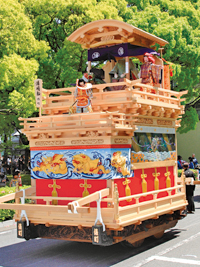
Tamanoi 【Funamachi】
Later, in the middle of the Edo Period, Ishibiki yama was changed by adding a doll representing a tenyo (female Japanese Buddhist angel) to the center pedestal on the first level, another one representing the god Hikohohodemi-no-mikoto under the yakata on the second level with a third representing Akamenryujin dancing in front of the god.
However, in 1815, this yama was severely damaged in a great flood. It was later restored and has been changed with a great deal of effort into a performance style yama, on which girls perform traditional Japanese dances on the stage for the delighted eyes of the audience.
Shōchiku 【Tenma-cho】
In the front part of Shōchiku is a stage for dancing, making this the only yama where there are both dancing children and performing karakuri dolls.
Atago 【Gifumachi】
On the left of the mid-level platform stands Takenouchi-no-Sukune, to the right stands a kyogen master, led on the lower platform by a third karakuri swinging branches. In this karakuri performance based on the noh play Yumihachiman, the old master becomes the god Kora (the embodiment of Takenouchi) and dances a sacred dance. A shinto priest then opens a box in which two doves appear, pecking at beans.
Shōjō 【Miyamachi】
For this karakuri performance, there is a large floor (called a toi) sticking out from this two tiered yama on which a large vase for alcohol rests. The Shōjō doll sticks its face into this vase and gets very drunk. Its face then turns beet red, and the doll suddenly turns into a shishi, or lion. Then the vase splits open and many peony flowers bloom forth from it while the lion tumbles and dances about crazily.
While its predecessor was regrettably destroyed in the fires of war in 1945, a new Shōjō was built from scratch 56 years later in March 2001. It has since been painted with Japanese lacquer, provided with metal fittings, and engraved.

For details, please click the banner on the left to visit the dedicated page.
| When | : | Saturday, May 11 and Sunday, May 12, 2024 8:00 a.m. ~ 9:30 p.m. |
| Where | : |
Ogaki City Public Regional Wholesale Market (161 Furumiya-cho, Ogaki City) |
| Access | : |
●From Ogaki IC: Take Route 258 north toward Ogaki, turn right at the Tsukizute-cho 5 intersection, and turn left at the Furumiya-cho intersection. ●From Ogaki Nishi IC: Immediately after the IC, go straight at the Hinoki-cho Intersection and follow the Ogaki Loop Road. Turn left at the Furumiya-cho intersection. ※Please set the phone number "0584-89-5131" as the destination in your car navigation system. |
| Shuttle bus | : |
The shuttle bus schedule and drop-off/pick-up locations are as follows. ●In front of Ogaki Castle Hall 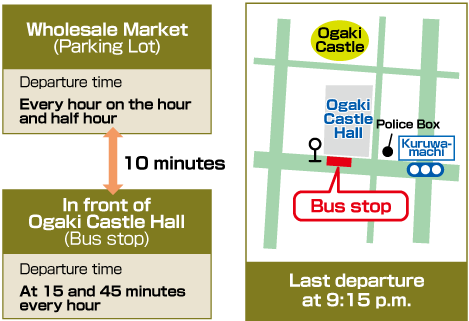 |
| Note | : | On the day of the Ogaki Festival, the Ogaki City Public Regional Wholesale Market will not be able to respond to inquiries by phone. We appreciate your understanding. |






